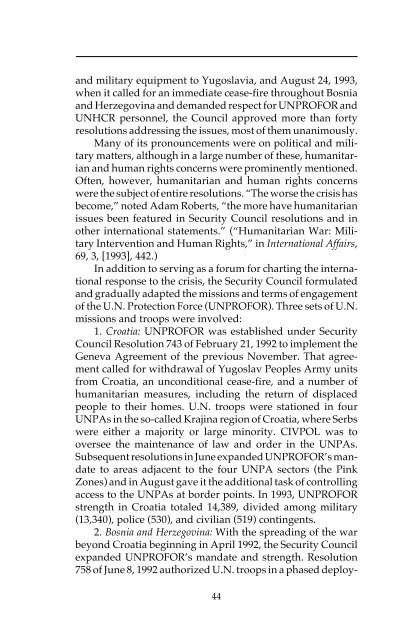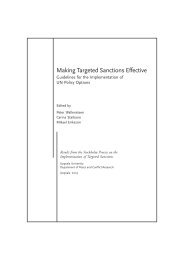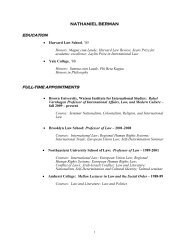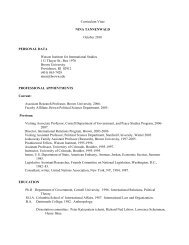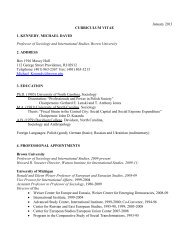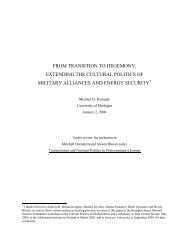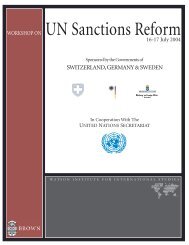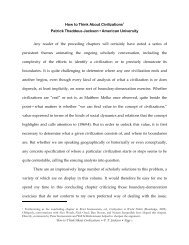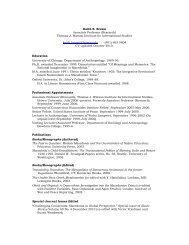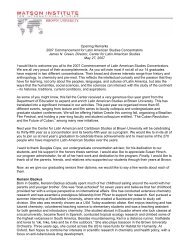op 18 front pages-converted - The Watson Institute for International ...
op 18 front pages-converted - The Watson Institute for International ...
op 18 front pages-converted - The Watson Institute for International ...
Create successful ePaper yourself
Turn your PDF publications into a flip-book with our unique Google optimized e-Paper software.
and military equipment to Yugoslavia, and August 24, 1993,<br />
when it called <strong>for</strong> an immediate cease-fire throughout Bosnia<br />
and Herzegovina and demanded respect <strong>for</strong> UNPROFOR and<br />
UNHCR personnel, the Council approved more than <strong>for</strong>ty<br />
resolutions addressing the issues, most of them unanimously.<br />
Many of its pronouncements were on political and military<br />
matters, although in a large number of these, humanitarian<br />
and human rights concerns were prominently mentioned.<br />
Often, however, humanitarian and human rights concerns<br />
were the subject of entire resolutions. “<strong>The</strong> worse the crisis has<br />
become,” noted Adam Roberts, “the more have humanitarian<br />
issues been featured in Security Council resolutions and in<br />
other international statements.” (“Humanitarian War: Military<br />
Intervention and Human Rights,” in <strong>International</strong> Affairs,<br />
69, 3, [1993], 442.)<br />
In addition to serving as a <strong>for</strong>um <strong>for</strong> charting the international<br />
response to the crisis, the Security Council <strong>for</strong>mulated<br />
and gradually adapted the missions and terms of engagement<br />
of the U.N. Protection Force (UNPROFOR). Three sets of U.N.<br />
missions and tro<strong>op</strong>s were involved:<br />
1. Croatia: UNPROFOR was established under Security<br />
Council Resolution 743 of February 21, 1992 to implement the<br />
Geneva Agreement of the previous November. That agreement<br />
called <strong>for</strong> withdrawal of Yugoslav Pe<strong>op</strong>les Army units<br />
from Croatia, an unconditional cease-fire, and a number of<br />
humanitarian measures, including the return of displaced<br />
pe<strong>op</strong>le to their homes. U.N. tro<strong>op</strong>s were stationed in four<br />
UNPAs in the so-called Krajina region of Croatia, where Serbs<br />
were either a majority or large minority. CIVPOL was to<br />
oversee the maintenance of law and order in the UNPAs.<br />
Subsequent resolutions in June expanded UNPROFOR’s mandate<br />
to areas adjacent to the four UNPA sectors (the Pink<br />
Zones) and in August gave it the additional task of controlling<br />
access to the UNPAs at border points. In 1993, UNPROFOR<br />
strength in Croatia totaled 14,389, divided among military<br />
(13,340), police (530), and civilian (519) contingents.<br />
2. Bosnia and Herzegovina: With the spreading of the war<br />
beyond Croatia beginning in April 1992, the Security Council<br />
expanded UNPROFOR’s mandate and strength. Resolution<br />
758 of June 8, 1992 authorized U.N. tro<strong>op</strong>s in a phased deploy-<br />
44


